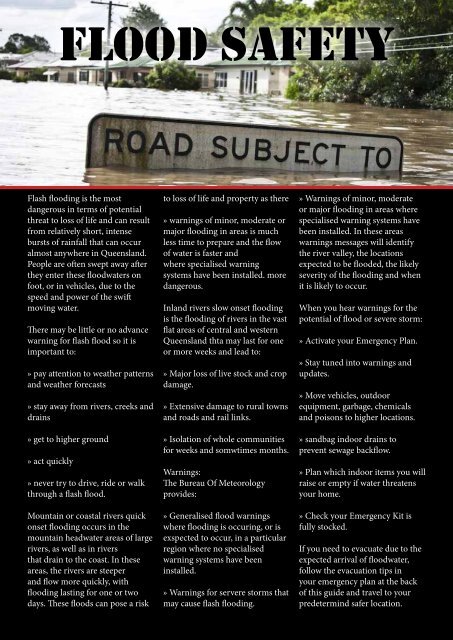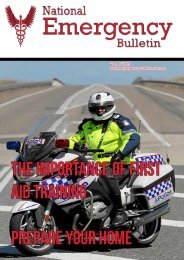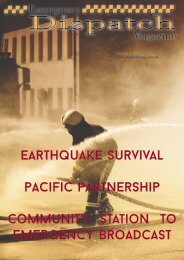National Emergency Magazine Vol. 4 2014
Create successful ePaper yourself
Turn your PDF publications into a flip-book with our unique Google optimized e-Paper software.
Flood Safety<br />
Flash flooding is the most<br />
dangerous in terms of potential<br />
threat to loss of life and can result<br />
from relatively short, intense<br />
bursts of rainfall that can occur<br />
almost anywhere in Queensland.<br />
People are often swept away after<br />
they enter these floodwaters on<br />
foot, or in vehicles, due to the<br />
speed and power of the swift<br />
moving water.<br />
There may be little or no advance<br />
warning for flash flood so it is<br />
important to:<br />
» pay attention to weather patterns<br />
and weather forecasts<br />
» stay away from rivers, creeks and<br />
drains<br />
» get to higher ground<br />
» act quickly<br />
» never try to drive, ride or walk<br />
through a flash flood.<br />
Mountain or coastal rivers quick<br />
onset flooding occurs in the<br />
mountain headwater areas of large<br />
rivers, as well as in rivers<br />
that drain to the coast. In these<br />
areas, the rivers are steeper<br />
and flow more quickly, with<br />
flooding lasting for one or two<br />
days. These floods can pose a risk<br />
to loss of life and property as there<br />
» warnings of minor, moderate or<br />
major flooding in areas is much<br />
less time to prepare and the flow<br />
of water is faster and<br />
where specialised warning<br />
systems have been installed. more<br />
dangerous.<br />
Inland rivers slow onset flooding<br />
is the flooding of rivers in the vast<br />
flat areas of central and western<br />
Queensland thta may last for one<br />
or more weeks and lead to:<br />
» Major loss of live stock and crop<br />
damage.<br />
» Extensive damage to rural towns<br />
and roads and rail links.<br />
» Isolation of whole communities<br />
for weeks and somwtimes months.<br />
Warnings:<br />
The Bureau Of Meteorology<br />
provides:<br />
» Generalised flood warnings<br />
where flooding is occuring, or is<br />
exspected to occur, in a particular<br />
region where no specialised<br />
warning systems have been<br />
installed.<br />
» Warnings for servere storms that<br />
may cause flash flooding.<br />
» Warnings of minor, moderate<br />
or major flooding in areas where<br />
specialised warning systems have<br />
been installed. In these areas<br />
warnings messages will identify<br />
the river valley, the locations<br />
expected to be flooded, the likely<br />
severity of the flooding and when<br />
it is likely to occur.<br />
When you hear warnings for the<br />
potential of flood or severe storm:<br />
» Activate your <strong>Emergency</strong> Plan.<br />
» Stay tuned into warnings and<br />
updates.<br />
» Move vehicles, outdoor<br />
equipment, garbage, chemicals<br />
and poisons to higher locations.<br />
» sandbag indoor drains to<br />
prevent sewage backflow.<br />
» Plan which indoor items you will<br />
raise or empty if water threatens<br />
your home.<br />
» Check your <strong>Emergency</strong> Kit is<br />
fully stocked.<br />
If you need to evacuate due to the<br />
expected arrival of floodwater,<br />
follow the evacuation tips in<br />
your emergency plan at the back<br />
of this guide and travel to your<br />
predetermind safer location.





